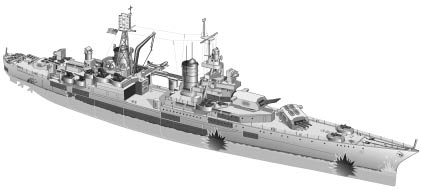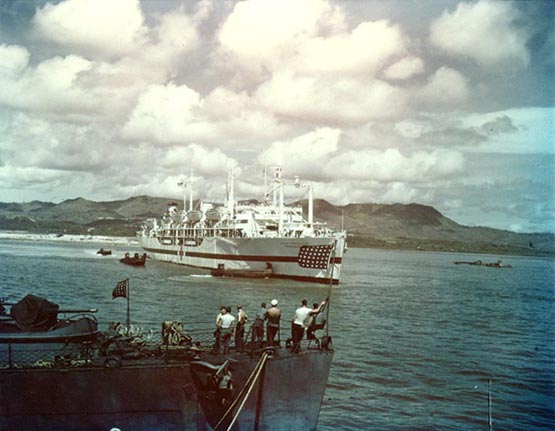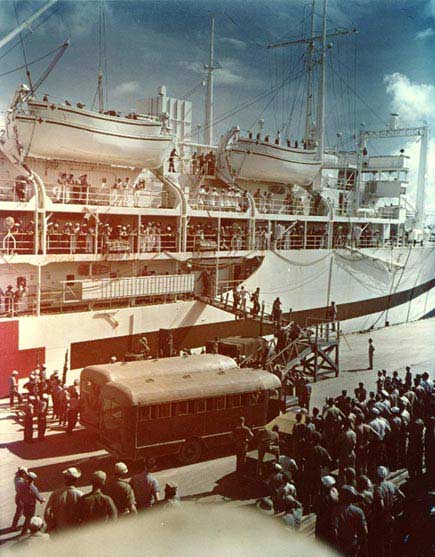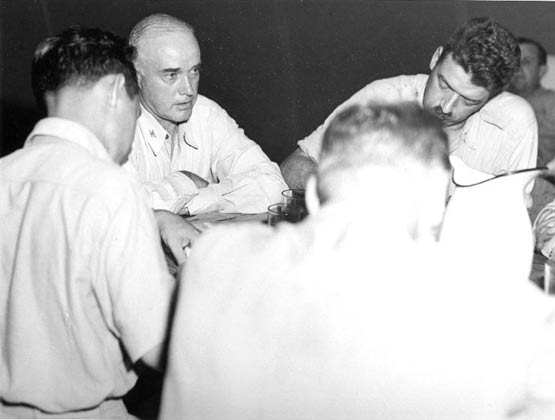INDIANAPOLIS TRAGEDY - Part 3
 TORPEDO DAMAGE TO INDIANAPOLIS |
 TRANQUILITY ARRIVES AT GUAM WITH SURVIVORS Navy Archives |
 TRANQUILITY UNLOADS SURVIVORS AT GUAM Navy Archives |
 CAPTAIN CHARLES BUTLER McVAY DISCUSSES TRAGEDY National Archives |
The following is the personal opinion of the writer and presents his view of what happened in the USS Indianapolis tragedy.
The 1945 sinking of the armored cruiser USS Indianapolis by the Imperial Japanese Submarine I-58 has been called the last great Naval tragedy of World War II.
Captain Charles McVay took command of the Indianapolis in November of 1944. It was the realization of a long-cherished dream. He graduated from Annapolis with the class of 1920, and was promoted to Captain on 18 June 1942. No stranger to attacks the ship was kept in the heat of battle until crashed by a Kamikaze in the Okinawa campaign. It was repaired at the Mare Island Navy Yard and was almost completed in July of 1945. McVay received an unexpected order to be ready for sea in four days. An air of secrecy surrounded the ship and there was no shortage of rumors. McVay was told he would receive two top secret pieces of cargo. The larger one was to be stowed on the quarterdeck and continually guarded. The smaller one would be guarded by two Army officers and kept in their quarters. All McVay knew was he would deliver the two boxes as soon as possible to Tinian. Everyone was guessing exactly what the boxes contained, but secrecy was extremely tight anywhere near them. The Atomic Bomb was the best kept secret of the war. Arriving at Tinian, the ship was met by a swarm of boats carrying Admirals, Generals, with everyone asking questions. The cargo was transferred to an LCT and delivered to a top secret area on Tinian, and by morning the Indianapolis was off Guam. After loading with fuel and ammo she was off to Leyte.
McVay was advised that three subs had been reported within 200 miles of the ships plotted course. He asked for an escort but was told none was available. Her top secret mission had also left her name deleted from arrival and departure boards. Due to the enemy sub activity McVay had orders to follow a zig zag course. At some point McVay decided his ship was not in danger of the reported subs and gave the order to cease the zig zag course. This decision played a big part in the Navy decision to press charges against him. It was definitely the biggest mistake he ever made. Violation of an order so important surely would not be overlooked, especially since it put the safety of the ship and the lives of the crew in danger. Shortly after midnight on 30 July 1945 the Indianapolis was torpedoed by the Japanese Sub I-58, and sank quickly. Due to the communication problem their radio SOS was apparently not sent. Her loss went unnoticed until spotted by accident by a passing aircraft on 2 August. So the controversy began as to what really happened on that fateful night, which put 1196 men in the water with only 317 surviving. The worst nightmare of anyones dreams happened the next five days. Survivors tales of terrifying shark attacks , horror, death, and despair have all been reported through the years. The crew endured unbelievable conditions, almost too incredible to report. Another matter of concern, exactly when did McVay give the "abandon ship" order, if indeed he ever did. The time difference becomes important when the question arises as to "when" it was given. The Navy immediately took a look at his delayed performance in issuing the order. Disobeying the order to zig zag definitely placed responsibility for the total loss of his ship and death to so many of his crew.
Another point which although not illegal was disturbing to the Navy. While hundreds of men were drowning, some without life preservers, most covered with oil, many being devoured by sharks, McVay was not seen among the crew. There were desperate men killing each other, some killing themselves. Suffering from hallucinations the group one of mass hysteria. How was it possible that so many men met such a horrible death while McVay was floating safely in a life raft?
The war was over, and the big news in all the newspapers was the sinking of the warship, and most blamed the Captain for putting the ship " in harms way". But someone had to take the blame, and McVay seemed to be the likely one. The Navy saw it was obvious the public at large would never give up, so an announcement was made that Captain McVay would face a court martial. The notice appeared on the front page of most newspapers. The Navy was convinced that McVay was to blame, and announced that it would bring the enemy Sub Commander who had actually sunk the Indianapolis to Washington to testify. This was an unprecedented procedure.